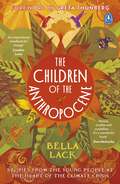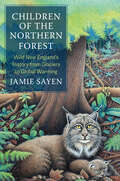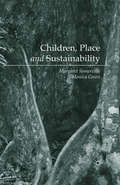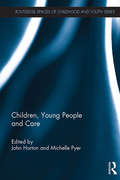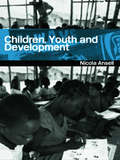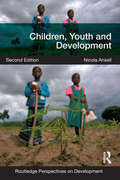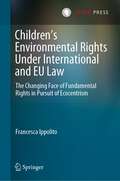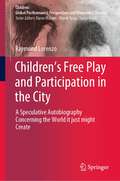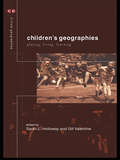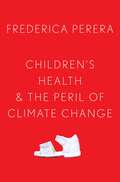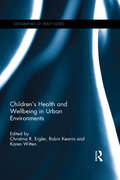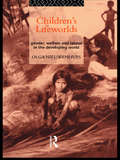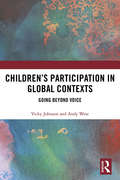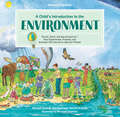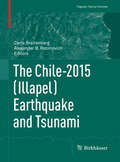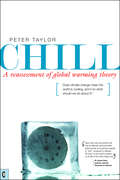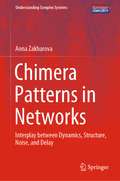- Table View
- List View
The Children of the Anthropocene: Stories from the Young People at the Heart of the Climate Crisis
by Bella Lack'An inspirational manifesto for change' Caroline Lucas, former leader of The Green Party 'A remarkable and important book' Steve Backshall, Naturalist, Broadcaster, and Author'Astute, erudite and crystalline, Bella writes with visionary clarity and passion [...] It's a wonderful book' Dara McAnulty, award-winning author of Diary of a Young Naturalist____________________________Across the planet, the futures of young people hang in the balance as they face the harsh realities of the environmental crisis. Isn't it time we made their voices heard?The Children of the Anthropocene, by conservationist and activist Bella Lack, chronicles the lives of the diverse young people on the frontlines of the environmental crisis around the world, amplifying the voices of those living at the heart of the crisis.Advocating for the protection of both people and the planet, Bella restores the beating heart to global environmental issues, from air pollution to deforestation and overconsumption, by telling the stories of those most directly affected. Transporting us from the humming bounty of Ecuador's Choco Rainforest and the graceful arcs of the Himalayan Mountains, to the windswept plains and vibrant vistas of life in Altiplano, Bella speaks to young activists from around the world including Dara McAnulty, Afroz Shah and Artemisa Xakriabá, and brings the crisis vividly to life.It's time we passed the mic and listened to different perspectives. Bella's manifestos for change will inspire and mobilize you to rediscover the wonders and wilds of nature and, ultimately, change the way you think about our planet in crisis. This is your chance to hear the urgent stories of an endangered species too often overlooked: the children of the Anthropocene. ____________________________'Extraordinarily moving, wild and engaging - the book of the moment' Mary Robinson, Former President of Ireland and author of Climate Justice'A visionary statement for the future [...] Pragmatic, positive & beautifully written' Ben Macdonald, Award-Winning Conservation Writer, Wildlife TV Producer and Naturalist
Children of the Northern Forest: Wild New England's History from Glaciers to Global Warming (Yale Agrarian Studies Series)
by Jamie SayenThis no-holds-barred narrative of the failure of conservation in northern New England’s forests envisions a wilder, more equitable, lower-carbon future for forest-dependent communities Jamie Sayen approaches the story of northern New England’s undeveloped forests from the viewpoints of the previously unheard: the forest and the nonhuman species it sustains, the First Peoples, and, in more recent times, the disenfranchised human voices of the forest, including those of loggers, mill workers, and citizens who, like Henry David Thoreau, wish to speak a kind word for nature. From 1988 to 2016 paper companies sold their timberlands and closed seventeen paper mills in northern New England. Policy makers ceded veto power to large absentee landowners, who tried to preserve the status quo by demanding additional tax cuts and other subsidies for economic elites. They vetoed measures designed to restore and preserve forest health; at present, about half of the former industrial forests are classified as degraded, and the regional economy continues to be trapped in low-value commodity markets. This book operates as a case study of how a rural resource region can respond to a global economy responsible for climate change, habitat loss and degradation, and environmental injustice. Sayen offers a blueprint for restoring vast wildlands and transitioning to a lower-carbon, high-value-adding, local economy, while protecting the natural rights of humans, nonhumans, and unborn generations.
Children, Place and Sustainability
by Margaret Somerville Monica GreenThrough focusing on children's sustainability learning this book examines how school education can address the current environmental problems. It explores children's responses in literacy and language, arts-based approaches, and indigenous studies as well as scientific pedagogies to provide a unique insight into how children learn.
Children, Young People and Care (Routledge Spaces of Childhood and Youth Series)
by John Horton Michelle PyerThe very notions of childhood and youth are intimately connected to contemporary norms, practices and spaces of care, caring and care-giving. The provision of care is widely figured as both the primary responsibility of parents, carers and practitioners who work with children and young people, and the primary factor in shaping children and young people’s development, education, socialisation, wellbeing and contentment. However, children and young people themselves are rarely figured as key actors in the provision of care. An overwhelming presumption that children and young people are to be cared for has effectively marginalised their agency and responsibilities as carers, or in relation to practices and spaces of care. Bringing together a significant array of multidisciplinary work on children, young people and families, this collection draws together new research on the diverse lives and experiences of children and young people as carers, as cared for, and in relation to spaces and institutions of care. It is the first collection specifically devoted to the subject of care in relation to childhood and youth. As such, the book will be a key resource for academics, practitioners and students seeking leading-edge empirical and conceptual material on this topic.
Children, Young People and Care (Routledge Spaces of Childhood and Youth Series)
by John Horton Michelle PyerThe very notions of childhood and youth are intimately connected to contemporary norms, practices and spaces of care, caring and care-giving. The provision of care is widely figured as both the primary responsibility of parents, carers and practitioners who work with children and young people, and the primary factor in shaping children and young people’s development, education, socialisation, wellbeing and contentment. However, children and young people themselves are rarely figured as key actors in the provision of care. An overwhelming presumption that children and young people are to be cared for has effectively marginalised their agency and responsibilities as carers, or in relation to practices and spaces of care. Bringing together a significant array of multidisciplinary work on children, young people and families, this collection draws together new research on the diverse lives and experiences of children and young people as carers, as cared for, and in relation to spaces and institutions of care. It is the first collection specifically devoted to the subject of care in relation to childhood and youth. As such, the book will be a key resource for academics, practitioners and students seeking leading-edge empirical and conceptual material on this topic.
Children, Youth and Development
by Nicola AnsellChildren constitute a large part of the population of developing countries. Throughout the developing world, experiences of childhood are extremely diverse, both between places and between children in particular places, from the international level through to the different treatment of a boy and a girl within the same household. This informative book considers issues such as education, child labour, street children, child soldiers, refugees, child slaves, the impact of environmental change and hazards on children and the way that children, with the enthusiasm and energy to bring about change, can be enabled to participate in 'development'.
Children, Youth and Development
by Nicola AnsellChildren constitute a large part of the population of developing countries. Throughout the developing world, experiences of childhood are extremely diverse, both between places and between children in particular places, from the international level through to the different treatment of a boy and a girl within the same household. This informative book considers issues such as education, child labour, street children, child soldiers, refugees, child slaves, the impact of environmental change and hazards on children and the way that children, with the enthusiasm and energy to bring about change, can be enabled to participate in 'development'.
Children, Youth and Development (Routledge Perspectives on Development)
by Nicola AnsellThe new updated edition of Children, Youth and Development explores the varied ways in which global processes in the form of development policies, economic and cultural globalisation, and international agreements interact with more locally specific practices to shape the lives of young people living in the poorer regions of the world. It examines these processes, and the effects they have on young people’s lives, in relation to developing theoretical approaches to the study of children and youth.? This landmark title brings together the stock of knowledge and approaches to understanding young people’s lives in the context of development and globalization in the majority world for the first time. It introduces different theoretical approaches to the study of young people, and explores the ways in which these, along with predominantly Western conceptions of childhood and youth, have influenced how majority world children have been viewed and treated by international agencies. Contexts of globalisation and growing international inequality are explored, alongside more immediate contexts such as family and peer relationships. Chapters are devoted to groups of children deemed to be in need of protection and to debates concerning children’s rights and their participation in development projects. Young people’s health and education are considered, as is their involvement in work of various kinds, and the impacts of environmental change and hazards (including climate change). The book introduces material and concepts to readers in a very accessible way and within each chapter employs features such as boxed case studies, summaries of key ideas, discussion questions and guides to further resources. This edition has been updated to take account of significant changes in the contexts in which poor children grow up, notably the financial crisis and changing development policy environment, as well as recent theoretical developments. It is aimed at students on higher level undergraduate and postgraduate courses, as well as researchers who are unfamiliar with this area of research and practitioners in organisations working to ameliorate the lives of children in majority world countries.
Children, Youth and Development (Routledge Perspectives on Development)
by Nicola AnsellThe new updated edition of Children, Youth and Development explores the varied ways in which global processes in the form of development policies, economic and cultural globalisation, and international agreements interact with more locally specific practices to shape the lives of young people living in the poorer regions of the world. It examines these processes, and the effects they have on young people’s lives, in relation to developing theoretical approaches to the study of children and youth.? This landmark title brings together the stock of knowledge and approaches to understanding young people’s lives in the context of development and globalization in the majority world for the first time. It introduces different theoretical approaches to the study of young people, and explores the ways in which these, along with predominantly Western conceptions of childhood and youth, have influenced how majority world children have been viewed and treated by international agencies. Contexts of globalisation and growing international inequality are explored, alongside more immediate contexts such as family and peer relationships. Chapters are devoted to groups of children deemed to be in need of protection and to debates concerning children’s rights and their participation in development projects. Young people’s health and education are considered, as is their involvement in work of various kinds, and the impacts of environmental change and hazards (including climate change). The book introduces material and concepts to readers in a very accessible way and within each chapter employs features such as boxed case studies, summaries of key ideas, discussion questions and guides to further resources. This edition has been updated to take account of significant changes in the contexts in which poor children grow up, notably the financial crisis and changing development policy environment, as well as recent theoretical developments. It is aimed at students on higher level undergraduate and postgraduate courses, as well as researchers who are unfamiliar with this area of research and practitioners in organisations working to ameliorate the lives of children in majority world countries.
Children’s Environmental Rights Under International and EU Law: The Changing Face of Fundamental Rights in Pursuit of Ecocentrism
by Francesca IppolitoThis book is dedicated to a topic which has for a long time lacked the attention it deserves within the academic world. It intends to address in a coherent and comprehensive manner the problem of the environmental rights of the child, which are not identical to the ones of adults whose environmental rights have been appraised from a general point of view. In the absence of any international law instrument explicitly granting a child the right to a clean environment, drawing on an extensive and original analysis of the UN Convention on the Rights of the Child and the practice of its monitoring body, this book undertakes an assessment of the extent to which these challenges may be overcome through a greater engagement between international law on the rights of the child and international environmental law. The result is the first comprehensive study on the manner in which these two mutually reinforcing legal regimes can interact to strengthen the protection of children’s environmental human rights at stake in the increased strategic environmental and climate litigations at both the national and international level. The book is recommended reading for, amongst others, policy makers, international environmental lawyers and human rights lawyers and practitioners. Additionally, lecturers, students and researchers from a range of disciplines will also gain from seeing how new legal scholarship and intertwined branches of international law contribute to the continual development of the living rights of the human rights conventions. Francesca Ippolito is Associate Professor of International Law in the Department of Political and Social Science of the University of Cagliari, Italy. She holds the Jean Monnet Chair on European Climate of Change - REACT for 2021-2024.
Children’s Free Play and Participation in the City: A Speculative Autobiography Concerning the World it just might Create (Children: Global Posthumanist Perspectives and Materialist Theories)
by Raymond LorenzoThis book presents an interplay of imaginative memoir-telling, action research data and future projection that reminds and inspires experiences academics, researchers, professionals, as well as a wider public to recognize the fundamental importance and the impellent need for more and better work in favour of true political and societal recognition of the needs and rights of children to play freely, to participate, to live fully and enjoy their neighbourhoods and cities, and to imagine and construct alternative futures, together with adults. The book's abundant spoken dialogue is, in effect, storytelling between children (and youth) on their own and with adults (especially the elderly). It conveys an appreciation of children’s special capacities to think critically about their everyday places—and the greater world around them—and to develop solutions (or ‘projects’) for the problems they identify. This book serves an effective catalyst for stimulating rich discussion of the theoretical and practical bases of the many themes, or areas of study, which are treated in the story.
Children's Geographies: Playing, Living, Learning (Critical Geographies)
by Gill Valentine Sarah L. HollowayChildren's Geographies is an overview of a rapidly expanding area of cutting edge research. Drawing on original research and extensive case studies in Europe, North and South America, Africa and Asia, the book analyses children's experiences of playing, living and learning.The diverse case studies range from an historical analysis of gender relationss in nineteenth century North American playgrounds through to children's experiences of after school care in contemporary Britain, to street cultures amongst homeless children in Indonesia at the end of the twentieth century. Threaded through this empirical diversity, is a common engagement with current debates about the nature of childhood.The individual chapters draw on contemporary sociological understandings of children's competence as social actors. In so doing they not only illustrate the importance of such an approach to our understandings of children's geographies, they also contribute to current debates about spatiality in the social studies of childhood.
Children's Geographies: Playing, Living, Learning (Critical Geographies)
by Gill Valentine Sarah L. HollowayChildren's Geographies is an overview of a rapidly expanding area of cutting edge research. Drawing on original research and extensive case studies in Europe, North and South America, Africa and Asia, the book analyses children's experiences of playing, living and learning.The diverse case studies range from an historical analysis of gender relationss in nineteenth century North American playgrounds through to children's experiences of after school care in contemporary Britain, to street cultures amongst homeless children in Indonesia at the end of the twentieth century. Threaded through this empirical diversity, is a common engagement with current debates about the nature of childhood.The individual chapters draw on contemporary sociological understandings of children's competence as social actors. In so doing they not only illustrate the importance of such an approach to our understandings of children's geographies, they also contribute to current debates about spatiality in the social studies of childhood.
Children's Health and the Peril of Climate Change
by Frederica PereraToday, approximately two billion children breathe toxic air at levels exceeding standards set by the World Health Organization, causing immediate and long-term physical and mental health effects. Nearly every child around the world is at risk from at least one climate-related shock such as severe heat, flooding, drought, air pollution, forest fires, water scarcity, and displacement. Air pollution and climate change, largely driven by emissions from fossil fuel, are widening inequality in children's health. From urban centers in the United States to remote villages in the furthest corners of Asia, we are seeing the effects of our inaction on climate change affecting the next generation--even those still in utero. The global transition away from fossil fuel to a low carbon economy creates a major opportunity for the health and future of our children, but only if we all take action. Children's Health and the Peril of Climate Change brings to light the mental and physical harms to children's health inflicted by climate change and its root cause--our addiction to fossil fuel. Drawing on the author's extensive expertise in children's environmental health, this essential and thought-provoking text exposes the unique vulnerability of the developing child and the multiple and synergistic effects of climate change and air pollution on child health, especially for disadvantaged children. However, it also shows how all children, regardless of their generational wealth or birth country, are imperiled by climate change. While this book provides specific evidence for the escalating dangers of climate change, it also presents a roadmap to a brighter future with case studies of climate change and air pollution policies that have benefitted children's health and the economy. Through facts and compelling storytelling, Frederica Perera shares the growing power of advocacy by youth, environmental justice, and Indigenous groups. She describes the many solutions now available, highlighting the need for integrated climate and social policies to accelerate the transition into a zero-carbon future. Leveraging the universally shared value of protecting children, Children's Health and the Peril of Climate Change is a call to action to replace denial and despair around climate change with purpose and commitment for a healthier, more sustainable future.
Children's Health and the Peril of Climate Change
by Frederica PereraToday, approximately two billion children breathe toxic air at levels exceeding standards set by the World Health Organization, causing immediate and long-term physical and mental health effects. Nearly every child around the world is at risk from at least one climate-related shock such as severe heat, flooding, drought, air pollution, forest fires, water scarcity, and displacement. Air pollution and climate change, largely driven by emissions from fossil fuel, are widening inequality in children's health. From urban centers in the United States to remote villages in the furthest corners of Asia, we are seeing the effects of our inaction on climate change affecting the next generation--even those still in utero. The global transition away from fossil fuel to a low carbon economy creates a major opportunity for the health and future of our children, but only if we all take action. Children's Health and the Peril of Climate Change brings to light the mental and physical harms to children's health inflicted by climate change and its root cause--our addiction to fossil fuel. Drawing on the author's extensive expertise in children's environmental health, this essential and thought-provoking text exposes the unique vulnerability of the developing child and the multiple and synergistic effects of climate change and air pollution on child health, especially for disadvantaged children. However, it also shows how all children, regardless of their generational wealth or birth country, are imperiled by climate change. While this book provides specific evidence for the escalating dangers of climate change, it also presents a roadmap to a brighter future with case studies of climate change and air pollution policies that have benefitted children's health and the economy. Through facts and compelling storytelling, Frederica Perera shares the growing power of advocacy by youth, environmental justice, and Indigenous groups. She describes the many solutions now available, highlighting the need for integrated climate and social policies to accelerate the transition into a zero-carbon future. Leveraging the universally shared value of protecting children, Children's Health and the Peril of Climate Change is a call to action to replace denial and despair around climate change with purpose and commitment for a healthier, more sustainable future.
Children's Health and Wellbeing in Urban Environments (Geographies of Health Series)
by Christina R. Ergler, Robin Kearns and Karen WittenHow children experience, negotiate and connect with or resist their surroundings impacts on their health and wellbeing. In cities, various aspects of the physical and social environment can affect children’s wellbeing. This edited collection brings together different accounts and experiences of children’s health and wellbeing in urban environments from majority and minority world perspectives. Privileging children’s expertise, this timely volume explicitly explores the relationships between health, wellbeing and place. To demonstrate the importance of a place-based understanding of urban children’s health and wellbeing, the authors unpack the meanings of the physical, social and symbolic environments that constrain or enable children’s flourishing in urban environments. Drawing on the expertise of geographers, educationists, anthropologists, psychologists, planners and public health researchers, as well as nurses and social workers, this book, above all, sees children as the experts on their experiences of the issues that affect their wellbeing. Children’s Health and Wellbeing in Urban Environments will be fascinating reading for anyone with an interest in cultural geography, urban geography, environmental geography, children’s health, youth studies or urban planning.
Children's Health and Wellbeing in Urban Environments (Geographies of Health Series)
by Christina R. Ergler Robin Kearns Karen WittenHow children experience, negotiate and connect with or resist their surroundings impacts on their health and wellbeing. In cities, various aspects of the physical and social environment can affect children’s wellbeing. This edited collection brings together different accounts and experiences of children’s health and wellbeing in urban environments from majority and minority world perspectives. Privileging children’s expertise, this timely volume explicitly explores the relationships between health, wellbeing and place. To demonstrate the importance of a place-based understanding of urban children’s health and wellbeing, the authors unpack the meanings of the physical, social and symbolic environments that constrain or enable children’s flourishing in urban environments. Drawing on the expertise of geographers, educationists, anthropologists, psychologists, planners and public health researchers, as well as nurses and social workers, this book, above all, sees children as the experts on their experiences of the issues that affect their wellbeing. Children’s Health and Wellbeing in Urban Environments will be fascinating reading for anyone with an interest in cultural geography, urban geography, environmental geography, children’s health, youth studies or urban planning.
Children's Lifeworlds: Gender, Welfare and Labour in the Developing World
by Olga NieuwenhuysChildren's Lifeworlds examines how working children face the challenge of having to combine work with school in Kerala. Moving beyond the usual concern with child labour and welfare to a critical assessment of the daily work routine of children, this book questions how class and kinship, gender and household organization, state ideology and education influence and conceal the lives of children in developing countries. Presenting an extraordinarily sympathetic and detailed case study of boys' and girls' work routine in a south Indian village, this book shows children creating the visibility of their work. The combination of personal experience, quantitative data and in-depth anthropological methods, sheds light on the world of those who, though they hold the future, have been left in the dark.
Children's Lifeworlds: Gender, Welfare and Labour in the Developing World
by Olga NieuwenhuysChildren's Lifeworlds examines how working children face the challenge of having to combine work with school in Kerala. Moving beyond the usual concern with child labour and welfare to a critical assessment of the daily work routine of children, this book questions how class and kinship, gender and household organization, state ideology and education influence and conceal the lives of children in developing countries. Presenting an extraordinarily sympathetic and detailed case study of boys' and girls' work routine in a south Indian village, this book shows children creating the visibility of their work. The combination of personal experience, quantitative data and in-depth anthropological methods, sheds light on the world of those who, though they hold the future, have been left in the dark.
Children’s Participation in Global Contexts: Going Beyond Voice
by Vicky Johnson Andy WestChildren's and young people’s right to participate has been increasingly acknowledged and taken up internationally, as expressed in the UN Convention on the Rights of the Child. Yet much of this has focused on collecting children’s voices, rather than achieving change, and has met its limits. This book provides an analysis of children’s participation in formal, collective and action research processes in six different international settings. It offers a deeper understanding of what helps and facilitates children's and young people’s participation through research, evaluation and decision-making to go beyond voice and effect change. This analysis is set in the context of historical and current discourses of participation, the sociology of childhood, contemporary anthropology, children’s geography and international development. Themes addressed include time and processes in children’s participation, shifting and multiple identities of children, political and cultural contexts, places and spaces children inhabit, skills and capacities of adults, accountability and power. The analysis promotes an approach to children’s participation as relational and collaborative, and will contribute to answering some of the questions facing practitioners and researchers embarking on participatory enquiry with children and young people. This is an invaluable book for practitioners and for scholars, postgraduates in anthropology, sociology, human geography, childhood studies, development studies, social policy, social work, community work, education, youth work and those with an interest in citizenship, children’s rights and human rights. Researchers and practitioners in UN, government and non-government services will also find it applicable to engaging with children and young people.
Children’s Participation in Global Contexts: Going Beyond Voice
by Vicky Johnson Andy WestChildren's and young people’s right to participate has been increasingly acknowledged and taken up internationally, as expressed in the UN Convention on the Rights of the Child. Yet much of this has focused on collecting children’s voices, rather than achieving change, and has met its limits. This book provides an analysis of children’s participation in formal, collective and action research processes in six different international settings. It offers a deeper understanding of what helps and facilitates children's and young people’s participation through research, evaluation and decision-making to go beyond voice and effect change. This analysis is set in the context of historical and current discourses of participation, the sociology of childhood, contemporary anthropology, children’s geography and international development. Themes addressed include time and processes in children’s participation, shifting and multiple identities of children, political and cultural contexts, places and spaces children inhabit, skills and capacities of adults, accountability and power. The analysis promotes an approach to children’s participation as relational and collaborative, and will contribute to answering some of the questions facing practitioners and researchers embarking on participatory enquiry with children and young people. This is an invaluable book for practitioners and for scholars, postgraduates in anthropology, sociology, human geography, childhood studies, development studies, social policy, social work, community work, education, youth work and those with an interest in citizenship, children’s rights and human rights. Researchers and practitioners in UN, government and non-government services will also find it applicable to engaging with children and young people.
A Child’s Introduction to the Environment: The Air, Earth, And Sea Around Us -- Plus Experiments, Projects, And Activities You Can Do To Help Our Planet! (A\child's Introduction Ser.)
by Michael Driscoll Dennis Driscoll Meredith HamiltonExplore the water, land, and air around us with this entertaining and informative look at our magnificent planet—and learn how your experiments, activities, and everyday actions can help save the environment. This book looks at the wide variety of ecosystems and environmental regions of the Earth, from deserts and forests, to cities and farms, to oceans and ice caps, as well as the atmosphere, weather, energy sources, plants, and animals of each area. Michael Driscoll and professor of meteorology Dennis Driscoll explain the changes to our planet that are currently taking place, including rising temperatures and sea levels, and the effects they can have on our environment. They also profile young environmental activists like Greta Thunberg and Isra Hirsi, and highlight important, everyday actions such as water conversion and recycling that kids can do on their own or with their parents. Also included are fun projects and experiments to do at home like brewing sun tea, creating lightning, and making a smog detector. Packed with facts, experiments, and a removable poster with tips on how to save the planet, this comprehensive guide will inspire kids and their families to think about our planet in new ways and help keep it beautiful and healthy for years to come.
The Chile-2015 (Pageoph Topical Volumes)
by Carla Braitenberg Alexander B. RabinovichThis volume presents a collection of contributions that were published in "Pure and Applied Geophysics - pageoph" and which deals with the major earthquake that hit Illapel, Chile on September 16, 2015 with magnitude 8.3, and associated trans-oceanic tsunami. The subducting Nazca plate beneath the Andes caused this major earthquake, generating strong shaking, permanent deformation, free oscillations of the Earth, and tsunamis. This event occurred in the flat-angle subducting segment of the plate.The generated tsunami spread throughout the entire Pacific Ocean and was recorded by numerous coastal tide gauges and open-ocean DART stations.All articles give an up-to-date account of research in one of the most active seismic zones worldwide. An introductory article by Kenji Satake rounds this collection off.
Chill, A Reassessment of Global Warming Theory: Does Climate Change Mean the World is Cooling, and If So What Should We Do About It?
by Peter TaylorAlthough the world’s climate has undergone many cyclical changes, the phrase ‘climate change’ has taken on a sinister meaning, implying catastrophe for humanity, ecology and the environment. We are told that we are responsible for this threat, and that we should act immediately to prevent it. But the apparent scientific consensus over the causes and effects of climate change is not what it appears.Chill is a critical survey of the subject by a committed environmentalist and scientist. Based on extensive research, it reveals a disturbing collusion of interests responsible for creating a distorted understanding of changes in global climate. Scientific institutions, basing their work on critically flawed computer simulations and models, have gained influence and funding. In return they have allowed themselves to be directed by the needs of politicians and lobbyists for simple answers, slogans and targets. The resulting policy - a 60% reduction of greenhouse-gas emissions by 2050 - would have a huge, almost unimaginable, impact upon landscape, community and biodiversity.On the basis of his studies of satellite data, cloud cover, ocean and solar cycles, Peter Taylor concludes that the main driver of recent global warming has been an unprecedented combination of natural events. His investigations indicate that the current threat facing humanity is a period of global cooling, comparable in severity to the Little Ice Age of 1400-1700 AD. The risks of such cooling are potentially greater than global warming and on a more immediate time scale, with the possibility of failing harvests leaving hundreds of millions vulnerable to famine. Drawing on his experience of energy policy and sustainability, Taylor suggests practical steps that should be taken now. He urges a shift away from mistaken policies that attempt to avert inevitable natural changes, to an adaptation to a climate that is likely overall to turn significantly cooler.
Chimera Patterns in Networks: Interplay between Dynamics, Structure, Noise, and Delay (Understanding Complex Systems)
by Anna ZakharovaThis is the first book devoted to chimera states - peculiar partial synchronization patterns in networks. Providing an overview of the state of the art in research on this topic, it explores how these hybrid states, which are composed of spatially separated domains of synchronized and desynchronized behavior, arise surprisingly in networks of identical units and symmetric coupling topologies. The book not only describes various types of chimeras, but also discusses the role of time delay, stochasticity, and network topology for these synchronization-desynchronization patterns. Moreover, it addresses the question of robustness and control of chimera states, which have various applications in physics, biology, chemistry, and engineering.This book is intended for researchers with a background in physics, applied mathematics, or engineering. Of great interest to specialists working on related problems, it is also a valuable resource for newcomers to the field and other scientists working on the control of spatio-temporal patterns.
